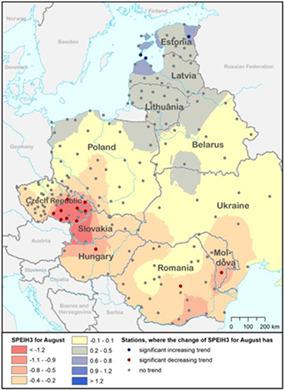当前位置:
X-MOL 学术
›
Int. J. Climatol.
›
论文详情
Our official English website, www.x-mol.net, welcomes your feedback! (Note: you will need to create a separate account there.)
Long-term changes in drought indices in eastern and central Europe
International Journal of Climatology ( IF 3.9 ) Pub Date : 2021-06-05 , DOI: 10.1002/joc.7241 Jaak Jaagus 1 , Anto Aasa 1 , Svetlana Aniskevich 2 , Boris Boincean 3 , Roxana Bojariu 4 , Agrita Briede 5 , Irina Danilovich 6 , Fernando Domínguez Castro 7, 8 , Alexandru Dumitrescu 4 , Martin Labuda 9 , Lívia Labudová 10 , Krista Lõhmus 1 , Viktar Melnik 6 , Kiira Mõisja 1 , Rita Pongracz 11 , Vera Potopová 12 , Ladislava Řezníčková 13, 14 , Egidijus Rimkus 15 , Inna Semenova 16 , Edvinas Stonevičius 15 , Petr Štěpánek 14, 17 , Miroslav Trnka 14, 18 , Sergio M. Vicente‐Serrano 19 , Joanna Wibig 20 , Pavel Zahradníček 14, 17
International Journal of Climatology ( IF 3.9 ) Pub Date : 2021-06-05 , DOI: 10.1002/joc.7241 Jaak Jaagus 1 , Anto Aasa 1 , Svetlana Aniskevich 2 , Boris Boincean 3 , Roxana Bojariu 4 , Agrita Briede 5 , Irina Danilovich 6 , Fernando Domínguez Castro 7, 8 , Alexandru Dumitrescu 4 , Martin Labuda 9 , Lívia Labudová 10 , Krista Lõhmus 1 , Viktar Melnik 6 , Kiira Mõisja 1 , Rita Pongracz 11 , Vera Potopová 12 , Ladislava Řezníčková 13, 14 , Egidijus Rimkus 15 , Inna Semenova 16 , Edvinas Stonevičius 15 , Petr Štěpánek 14, 17 , Miroslav Trnka 14, 18 , Sergio M. Vicente‐Serrano 19 , Joanna Wibig 20 , Pavel Zahradníček 14, 17
Affiliation

|
This study analyses long-term changes in drought indices (Standardised Precipitation Index—SPI, Standardised Precipitation–Evapotranspiration Index—SPEI) at 1 and 3 months scales at 182 stations in 11 central and eastern European countries during 1949–2018. For comparative purposes, the necessary atmospheric evaporative demand (AED) to obtain SPEI was calculated using two methods, Hargreaves-Samani (SPEIH) and Penman-Monteith (SPEIP). The results show some relevant changes and tendencies in the drought indices. Statistically significant increase in SPI and SPEI during the cold season (November–March), reflecting precipitation increase, was found in the northern part of the study region, in Estonia, Latvia, Lithuania, northern Belarus and northern Poland. In the rest of study domain, a weak and mostly insignificant decrease prevailed in winter. Summer season (June–August) is characterized by changes in the opposite sign. An increase was observed in the north, while a clear decrease in SPEI, reflecting a drying trend, was typical for the southern regions: the Czech Republic, Slovakia, Hungary, Romania, Moldova and southern Poland. A general drying tendency revealed also in April, which was statistically significant over a wide area in the Czech Republic and Poland. Increasing trends in SPI and SPEI for September and October were detected in Romania, Moldova and Hungary. The use of SPEI instead of SPI generally enhances drying trends.
中文翻译:

东欧和中欧干旱指数的长期变化
本研究分析了 1949-2018 年间 11 个中欧和东欧国家的 182 个站点在 1 个月和 3 个月尺度上的干旱指数(标准化降水指数-SPI、标准化降水-蒸散指数-SPEI)的长期变化。出于比较目的,获得 SPEI 所需的大气蒸发需求 (AED) 使用两种方法计算,即 Hargreaves-Samani (SPEIH) 和 Penman-Monteith (SPEIP)。结果显示了干旱指数的一些相关变化和趋势。在研究区域的北部、爱沙尼亚、拉脱维亚、立陶宛、白俄罗斯北部和波兰北部发现,在寒冷季节(11 月至 3 月),SPI 和 SPEI 的统计显着增加,反映了降水的增加。在其他研究领域,冬季普遍出现微弱且几乎不显着的下降。夏季(6 月至 8 月)的特点是相反星座的变化。在北部观察到增加,而 SPEI 明显下降,反映了干燥趋势,这是南部地区的典型特征:捷克共和国、斯洛伐克、匈牙利、罗马尼亚、摩尔多瓦和波兰南部。4 月份也出现了普遍的干燥趋势,这在捷克共和国和波兰的广大地区具有统计学意义。在罗马尼亚、摩尔多瓦和匈牙利,9 月和 10 月的 SPI 和 SPEI 呈上升趋势。使用 SPEI 代替 SPI 通常会增强干燥趋势。摩尔多瓦和波兰南部。4 月份也出现了普遍的干燥趋势,这在捷克共和国和波兰的广大地区具有统计学意义。在罗马尼亚、摩尔多瓦和匈牙利,9 月和 10 月的 SPI 和 SPEI 呈上升趋势。使用 SPEI 代替 SPI 通常会增强干燥趋势。摩尔多瓦和波兰南部。4 月份也出现了普遍的干燥趋势,这在捷克共和国和波兰的广大地区具有统计学意义。在罗马尼亚、摩尔多瓦和匈牙利,9 月和 10 月的 SPI 和 SPEI 呈上升趋势。使用 SPEI 代替 SPI 通常会增强干燥趋势。
更新日期:2021-06-05
中文翻译:

东欧和中欧干旱指数的长期变化
本研究分析了 1949-2018 年间 11 个中欧和东欧国家的 182 个站点在 1 个月和 3 个月尺度上的干旱指数(标准化降水指数-SPI、标准化降水-蒸散指数-SPEI)的长期变化。出于比较目的,获得 SPEI 所需的大气蒸发需求 (AED) 使用两种方法计算,即 Hargreaves-Samani (SPEIH) 和 Penman-Monteith (SPEIP)。结果显示了干旱指数的一些相关变化和趋势。在研究区域的北部、爱沙尼亚、拉脱维亚、立陶宛、白俄罗斯北部和波兰北部发现,在寒冷季节(11 月至 3 月),SPI 和 SPEI 的统计显着增加,反映了降水的增加。在其他研究领域,冬季普遍出现微弱且几乎不显着的下降。夏季(6 月至 8 月)的特点是相反星座的变化。在北部观察到增加,而 SPEI 明显下降,反映了干燥趋势,这是南部地区的典型特征:捷克共和国、斯洛伐克、匈牙利、罗马尼亚、摩尔多瓦和波兰南部。4 月份也出现了普遍的干燥趋势,这在捷克共和国和波兰的广大地区具有统计学意义。在罗马尼亚、摩尔多瓦和匈牙利,9 月和 10 月的 SPI 和 SPEI 呈上升趋势。使用 SPEI 代替 SPI 通常会增强干燥趋势。摩尔多瓦和波兰南部。4 月份也出现了普遍的干燥趋势,这在捷克共和国和波兰的广大地区具有统计学意义。在罗马尼亚、摩尔多瓦和匈牙利,9 月和 10 月的 SPI 和 SPEI 呈上升趋势。使用 SPEI 代替 SPI 通常会增强干燥趋势。摩尔多瓦和波兰南部。4 月份也出现了普遍的干燥趋势,这在捷克共和国和波兰的广大地区具有统计学意义。在罗马尼亚、摩尔多瓦和匈牙利,9 月和 10 月的 SPI 和 SPEI 呈上升趋势。使用 SPEI 代替 SPI 通常会增强干燥趋势。



























 京公网安备 11010802027423号
京公网安备 11010802027423号